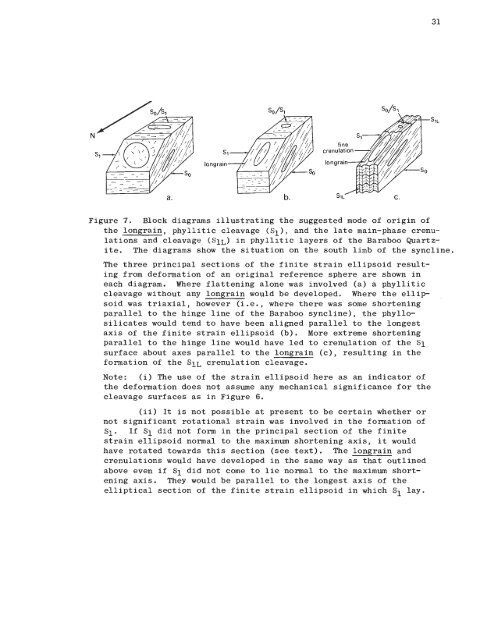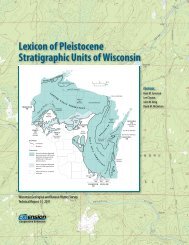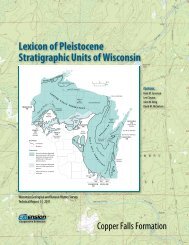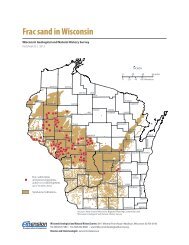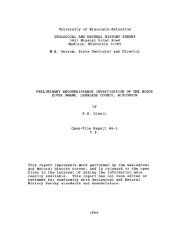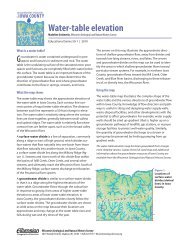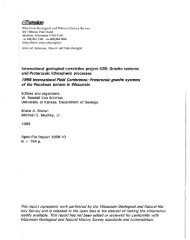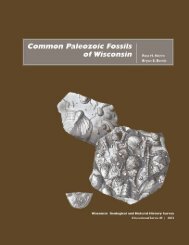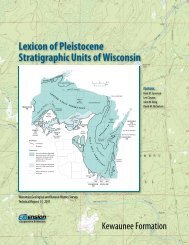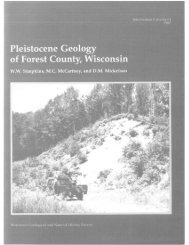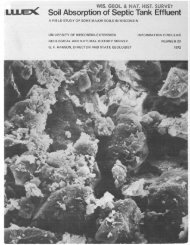IC14. Geology of the Baraboo District, Wisconsin: A description and ...
IC14. Geology of the Baraboo District, Wisconsin: A description and ...
IC14. Geology of the Baraboo District, Wisconsin: A description and ...
Create successful ePaper yourself
Turn your PDF publications into a flip-book with our unique Google optimized e-Paper software.
fine<br />
crenulation<br />
longrain-<br />
Figure 7. Block diagrams illustrating <strong>the</strong> suggested mode <strong>of</strong> origin <strong>of</strong><br />
<strong>the</strong> longrain, phyllitic cleavage (S1), <strong>and</strong> <strong>the</strong> late main-phase crenu-<br />
lations <strong>and</strong> cleavage (SIL) in phyllitic layers <strong>of</strong> <strong>the</strong> <strong>Baraboo</strong> Quartz-<br />
ite. The diagrams show <strong>the</strong> situation on <strong>the</strong> south limb <strong>of</strong> <strong>the</strong> syncline.<br />
The three principal sections <strong>of</strong> <strong>the</strong> finite strain ellipsoid result-<br />
ing from deformation <strong>of</strong> an original reference sphere are shown in<br />
each diagram. Where flattening alone was involved (a) a phyllitic<br />
cleavage without any longrain would be developed. Where <strong>the</strong> ellip-<br />
soid was triaxial, however (i.e., where <strong>the</strong>re was some shortening<br />
parallel to <strong>the</strong> hinge line <strong>of</strong> <strong>the</strong> <strong>Baraboo</strong> syncline), <strong>the</strong> phyllo-<br />
silicates would tend to have been aligned parallel to <strong>the</strong> longest<br />
axis <strong>of</strong> <strong>the</strong> finite strain ellipsoid (b). More extreme shortening<br />
parallel to <strong>the</strong> hinge line would have led to crenulation <strong>of</strong> <strong>the</strong> S1<br />
surface about axes parallel to <strong>the</strong> longrain (c), resulting in <strong>the</strong><br />
formation <strong>of</strong> <strong>the</strong> SIL crenulation cleavage.<br />
Note: (i) The use <strong>of</strong> <strong>the</strong> strain ellipsoid here as an indicator <strong>of</strong><br />
<strong>the</strong> deformation does not assume any mechanical significance for <strong>the</strong><br />
cleavage surfaces as in Figure 6.<br />
(ii) It is not possible at present to be certain whe<strong>the</strong>r or<br />
not significant rotational strain was involved in <strong>the</strong> formation <strong>of</strong><br />
S1. If S1 did not form in <strong>the</strong> principal section <strong>of</strong> <strong>the</strong> finite<br />
strain ellipsoid normal to <strong>the</strong> maximum shortening axis, it would<br />
have rotated towards this section (see text). The longrain <strong>and</strong><br />
crenulations would have developed in <strong>the</strong> same way as that outlined<br />
above even if S1 did not come to lie normal to <strong>the</strong> maximum short-<br />
ening axis. They would be parallel to <strong>the</strong> longest axis <strong>of</strong> <strong>the</strong><br />
elliptical section <strong>of</strong> <strong>the</strong> finite strain ellipsoid in which S1 lay.


